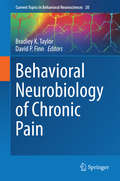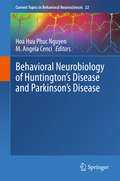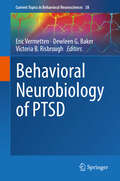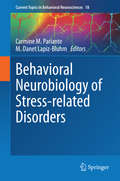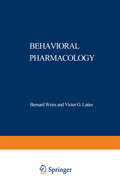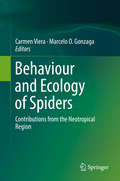- Table View
- List View
Behavioral Lateralization in Vertebrates: Two Sides of the Same Coin
by Davide Csermely and Lucia RegolinFunctional lateralization in the human brain was first identified in the classic observations by Broca in the 19th century. Only one hundred years later, however, research on this topic began anew, discovering that humans share brain lateralization not only with other mammals, but with other vertebrates and even invertebrates. Studies on lateralization have also received considerable attention in recent years due to their important evolutionary implications, becoming an important and flourishing field of investigation worldwide among ethnologists and psychologists.The chapters of this book concern the emergence and adaptive function of lateralization in several aspects of behavior for a wide range of vertebrate taxa. These studies span from how lateralization affects some aspects of fitness in fishes, or how it affects the predatory and the exploratory behavior of lizards, to navigation in the homing flights of pigeons, social learning in chicks, the influence of lateralization on the ontogeny process of chicks, and the similarity of manual lateralization (handedness) between humans and apes, our closest relatives.
Behavioral Neurobiology of Aging (Current Topics in Behavioral Neurosciences #10)
by Marie-Christine Pardon and Mark W. BondiThis volume discusses the current state of research findings related to healthy brain aging by integrating human clinical studies and translational research in animal models. Several chapters offer a unique overview of successful aging, age-related cognitive decline and its associated structural and functional brain changes, as well as how these changes are influenced by reproductive aging. Insights provided by preclinical studies in mouse models and advanced neuroimaging techniques in humans are also presented.
Behavioral Neurobiology of Chronic Pain (Current Topics in Behavioral Neurosciences #20)
by Bradley K. Taylor David P. FinnPain is the most common reason people seek medical help. The treatment of chronic pain is a major unmet clinical need and its impact on health, well-being, society and the economy is immense. Pain is an integrative, whole-systems (patho)physiological phenomenon and behavioural neuroscience plays a key role in advancing our understanding of pain. This volume brings together a series of authoritative chapters written by leading experts in preclinical and clinical aspects of pain neurobiology. Behavioural approaches to the study of persistent or chronic pain in animal models or humans are at the core of the volume, but the anatomical, physiological, neurochemical and molecular mechanisms that underpin behavioural alterations are also emphasized.
Behavioral Neurobiology of Huntington's Disease and Parkinson's Disease (Current Topics in Behavioral Neurosciences #22)
by Hoa Huu Phuc Nguyen M. Angela CenciMotor dysfunction and cognitive impairment are major symptoms in both Huntington’s Disease (HD) and Parkinson’s Disease (PD). A breakthrough in HD research was the identification of the gene that causes this devastating monogenetic illness. Similarly, several genes were found to cause familial forms of PD. With their identification, a plethora of genetic animal models has been generated and has revolutionized the understanding of the pathobiology and pathophysiology of these disorders. The models allow us to study the earliest manifestations of the diseases behaviorally and neuropathologically and help us understand how they progress over time. Additionally, neurotoxic animal models are still of high interest to the PD field, as they are being used to study e.g. mitochondrial dysfunction in PD. This book focuses on animal models of both diseases and how they have helped and will continue to help understand the behavioral neurobiology in these disorders.
Behavioral Neurobiology of PTSD (Current Topics in Behavioral Neurosciences #38)
by Eric Vermetten Dewleen G. Baker Victoria B. RisbroughThis volume focuses on the behavioral neuroscience that supports our understanding of the neurobiology of trauma risk and response. The collection of articles focuses on both preclinical and clinical reviews of (1) state-of-the-art knowledge of mechanisms of posttraumatic stress disorder (PTSD) and co-occurring disorders, (2) the biological and psychological constructs that support risk and resiliency for trauma disorders, and (3), novel treatment strategies and therapeutics on the horizon.
Behavioral Neurobiology of Stress-related Disorders (Current Topics in Behavioral Neurosciences #18)
by Carmine M. Pariante M. Danet Lapiz-BluhmStress is such an over-used word that it is at time difficult to define its core features. When is an environment stressful? What does a stressful environment do to the brain and to the body? What are the biological mechanisms by which a stressor affects us? How does stress contributes to the onset and the progression of mental disorders? How do the effects of stress change over the life-time of an individual? These are just some of the overarching questions addressed by this book, thanks to the contribution of some of the world leading experts on the neurobiology of stress at the pre-clinical and clinical levels. Topics include current advances on the neurobiology of stress on various neurobiological systems such as immune, hypothalamic-pituitary-adrenal (HPA) axis, neurogenesis and neuroplasticity, neurotransmitter (glutamate, noradrenaline, dopamine, serotonin and endocannabinoid), neuropeptides, cognition and emotional processing as well as in utero and early postnatal effects. The clinical chapters deal with the relationship of stress and mental disorders such as depression, posttraumatic stress disorder (PTSD), anxiety disorders, schizophrenia, bipolar disorder, substance abuse and addiction, dementia and age-related cognitive decline as well as resilience to stress. Thus, this book brings together some of the most updated and authoritative views on the effects of stress of brain and behavior.
Behavioral Neurogenetics (Current Topics in Behavioral Neurosciences #12)
by John F. Cryan and Andreas ReifThis book covers a wide array of topics relevant to behavioral genetics from both a preclinical and clinical standpoint. Indeed in juxtaposing both areas of research the reader will appreciate the true translational nature of the field. Topics covered range from technical advances in genetic analysis in humans and animals to specific descriptions of advances in schizophrenia, attention disorders, depression and anxiety disorders, autism, aggression, neurodegeneration and neurodevelopmental disorders. The importance of gene-environment interactions is emphasised and the role of neuroimaging in unravelling the functional consequences of genetic variability described. This volume will be valued by both the basic scientist and clinician alike who may use it as a detailed reference book. It will also be of use to the novice to the field, to whom it will serve as an in-depth introduction to this exciting area of research.
The Behavioral Neuroscience of Drug Discrimination (Current Topics in Behavioral Neurosciences #39)
by Joseph H. Porter Adam J. PrusThe goal for this volume is to provide an up-to-date review of the discriminative stimulus properties of major psychoactive drug classes with an emphasis on how this paradigm enhances our understanding of these drugs and how these findings translate from animals to humans. The drug discrimination paradigm applies to both drugs of abuse and drugs for treating mental illnesses, and research from these studies has provided immense translational value for learning about the mechanisms responsible for drug effects in humans.
Behavioral Neuroscience of Learning and Memory (Current Topics in Behavioral Neurosciences #37)
by Robert E. Clark Stephen Martin‘Behavioral Neuroscience of Learning and Memory’ brings together the opinions and expertise of some of the world’s foremost neuroscientists in the field of learning and memory research. The volume provides a broad coverage of contemporary research and thinking in this field, focusing both on well established topics such as the medial temporal lobe memory system, as well as emerging areas of research such as the role of memory in decision making and the mechanisms of perceptual learning. Key intersecting themes include the molecular and cellular mechanisms of memory formation, the multiplicity of memory systems in the brain, and the way in which technological innovation is driving discovery. Unusually for a volume of this kind, this volume brings together research from both humans and animals—often relatively separate areas of discourse—to give a more comprehensive and integrated view of the field. The book will be of interest to both established researchers who wish to broaden their knowledge of topics outside of their specific areas of expertise, and for students who need a resource to help them make sense of the vast scientific literature on this subject.
Behavioral Neuroscience of Motivation (Current Topics in Behavioral Neurosciences #27)
by Eleanor H. Simpson Peter D. BalsamThis volume covers the current status of research in the neurobiology of motivated behaviors in humans and other animals in healthy condition. This includes consideration of the psychological processes that drive motivated behavior and the anatomical, electrophysiological and neurochemical mechanisms which drive these processes and regulate behavioural output. The volume also includes chapters on pathological disturbances in motivation including apathy, or motivational deficit as well as addictions, the pathological misdirection of motivated behavior. As with the chapters on healthy motivational processes, the chapters on disease provide a comprehensive up to date review of the neurobiological abnormalities that underlie motivation, as determined by studies of patient populations as well as animal models of disease. The book closes with a section on recent developments in treatments for motivational disorders.
Behavioral Neuroscience of Orexin/Hypocretin (Current Topics in Behavioral Neurosciences #33)
by Andrew J. Lawrence Luis De LeceaThis issue of Current Topics in Behavioral Neuroscience focuses on the neuropeptide orexin (hypocretin) and brings together scientists from around the world who will provide a timely discussion of how this peptide regulates behavior. This is a fast-moving field, and with the incorporation of novel technologies, new breakthroughs are likely to continue. For example, the use of optogenetic approaches has enabled the identification of the role of orexin-containing neurons in arousal states, critical for higher order functioning. From a clinical perspective, genetic polymorphisms in hypocretin/orexin and orexin receptors are implicated in a number of psychiatric disorders. In addition, advanced clinical trials are currently underway for orexin receptor antagonists in the treatment of insomnia and sleep disorders. We aim to capture a broad audience of basic scientists and clinicians.
The Behavioral Neuroscience of the Septal Region
by Robert NumanA review of our understanding of this area of the brain, showing how it fits into the general picture of those areas concerned with modulating mammalian behavior. The chapters, all written by leading figures in behavioral neuroscience, discuss the anatomy, neurochemistry, physiology, and behavioral relations in the septal area. Due to the great deal of current research shown in the related areas of hippocampus and the amygdala, this book will be of great interest to all those who research the hippocampus and the amygdala in addition to the septum itself.
Behavioral Pediatrics: Research and Practice
by Dennis C. RussoAs in any field of clinical or scientific endeavor, a cataloguing of the techniques and findings of behavioral pediatrics must follow shortly after the first few years of systematic work. This book has been designed to serve this initial summary function for the field. It represents a first attempt to bring together in one place the definition and scope of be havioral pediatrics and to outline current research and treatment ap proaches to various organic disorders, clinical settings, and problem areas in which a sufficient body of knowledge has accrued for author itative statement. As the first text in a rapidly expanding area, our decisions regarding the topics to be covered and the contributors to this volume were guided by our desire to represent what we would consider to exemplify the field in its early development: pragmatic and thorough study of signif icant problems from a base of sound scientific inquiry. Each of the topics addressed in the present volume develops, in a preliminary fashion, an epistemology for current practice and future study. All of the contrib uting authors have been involved in the development of their specialty areas through their research and, importantly, through their clinical work in the hospitals affiliated with the medical schools in which they hold appointments.
Behavioral Pharmacology of Neuropeptides: Oxytocin (Current Topics in Behavioral Neurosciences #35)
by Rene Hurlemann Valery GrinevichThis volume collects cutting-edge expert reviews in the oxytocin field and will be of interest to a broad scientific audience ranging from social neuroscience to clinical psychiatry. The role of the neuropeptide oxytocin in social behaviors is one of the earliest and most significant discoveries in social neuroscience. Influential studies in animal models have delineated many of the neural circuits and genetic components that underlie these behaviors. These discoveries have inspired researchers to investigate the effects of oxytocin on brain and behavior in humans and its potential relevance as a treatment for psychiatric disorders including borderline personality disorder and autism and schizophrenia spectrum disorders. In fact, there is no established social psychopharmacology in Psychiatry, and oxytocin can be seen as the first endogenous agent specifically addressing social-cognitive impairment in psychiatric disorders, with animal research suggesting that it could be especially efficient in the early postnatal period. From a human perspective, it is crucial to understand more precisely who can benefit from potential oxytocin-related treatments, which outcome measures will best represent their effects, how they should be administered, and what brain mechanisms are likely involved in mediating their effects. This type of “precision medicine” approach is in line with the research domain criteria defined by the U.S. National Institute of Mental Health.
Behaviour and Ecology of Spiders: Contributions from the Neotropical Region
by Carmen Viera Marcelo O. GonzagaWithin the last few decades, arachnology in the Neotropical region has experienced a great development filling the knowledge gap in one of the most diverse regions of the world. Nevertheless, large geographical areas remain poorly sampled, especially within the Amazon, and new genera and species have been continuously discovered, even in urban areas. In congruence with the recent improvements in research, several aspects of the ecology, behaviour and natural history of spiders, such as interactions with other predators and parasitoids, social interactions, dispersal patterns, habitat requirements, mating behaviors, among others, are being carefully investigated. These recent contributions incorporate substantial information on the preexisting knowledge on these subjects every year. Our main objective with this book is to present a summary on these new researches and on the currently knowledge on the main subjects involved in the general theme, emphasizing the contribution of the rich fauna of the Neotropical region to the research of behaviour and ecology of the spiders.
The Behaviour of Pinnipeds
by D. RenoufWe teach our students of behavioural science that one first defines a research problem, and then the most appropriate animal is selected to investigate hypotheses. The reverse order of events is improper: a particular class of animals should not be studied for its own sake. In the case of the Pinnipeds (seals, sea lions, fur seals and walruses) the organism and the problem are essentially the same. The research questions presented in this volume in one way or another relate to survival in two worlds, the ocean for foraging, and the terrain at its edge or frozen above it for breeding. The evolution of Pinniped behaviour and the mechanisms which underlie it are a consequence of having to cope with two seemingly incompatible sets of environmental constraints. The physiological adaptations for concomitant functioning in two media with very different physical characteristics have produced correlated behav ioural modifications. The energetic demands of reproduction and foraging are idiosyncratic because each activity occurs on opposite sides of the air/water interface. As a result, the mating system must reconcile aquatic design for such functions as locomotion and thermoregulation, with the terrestrial requirements for successful pupping. Similarly, the ecology of this dual habitat prescribes the rules governing the behaviour of the neonate and its interactions with its mother.
Behaviour Problems in Small Animals E-Book: Practical Advice for the Veterinary Team
by Jon Bowen Sarah HeathThis compact, easy-access guide to behavioral problems encountered in veterinary practice offers immediate and helpful advice for today's veterinary team. Instructor resources are available; please contact your Elsevier sales representative for details.Coverage offers immediate advice to the veterinary team who are often presented with behavioral problems in their practice.Easy-to-read format includes introductions, medical differentials, underlying causes, diagnosis, action boxes, and summaries.Content refers the reader to other chapters throughout the book, so that information can be found quickly and easily.Helpful handouts, which can be photocopied, offer yet another way to further your learning experience.
Behavioural Adaptations of Desert Animals (Adaptations of Desert Organisms)
by Giovanni CostaAfter a brief survey of biotopic and vegetational features and an account of the main groups of desert animals, the most unusual patterns of the behaviour of the xerophilous fauna are examined. The importance of the thermohygric regulation and self-protective and locomotor mechanisms to the survival of arid-adapted animals is emphasized and various adaptations in the alimentary, reproductive and social spheres are analyzed.The clear and fluent treatment will awaken the interest of the reading public, from the amateur naturalists to research scientists.
The Behavioural Biology of Zoo Animals
by Paul Rose"Zoo animals" as a population are a diverse array of species from all around the globe. When managed in captivity, it is important that key aspects of natural ecology are factored into animal care, as well as considerations relating to welfare, life history and behavioural needs. The Behavioural Biology of Zoo Animals is the first book on captive animal behaviour and how this applies to welfare. The book enables all aspects of zoo husbandry and management (nutrition, enclosure design, handling and training, enrichment, population management) to be based on a sound knowledge of the species, its evolutionary history and its natural history. Chapters from expert authors cover a vast range of taxa, from primates and elephants to marine mammals and freshwater fish, to reptiles, birds and invertebrates. A final part looks to the future, considering animal health and wellbeing, the visitor experience and future visions for zoos and aquariums. For on-the-ground practitioners as well as students of zoo biology, animal science and welfare, this book provides an explanation of key areas of behavioural biology that are important to fulfilling the aims of the modern zoo (conservation, education, research and recreation). It explains how evidence from the wild can be implemented into captive care to support the wider aims of the zoo, shedding light on the evidence-based approaches applied to zoo biology and animal management. Chapter 3 is available to download Open Access on the www.taylorfrancis.com website.
The Behavioural Biology of Zoo Animals
by Paul Rose"Zoo animals" as a population are a diverse array of species from all around the globe. When managed in captivity, it is important that key aspects of natural ecology are factored into animal care, as well as considerations relating to welfare, life history and behavioural needs. The Behavioural Biology of Zoo Animals is the first book on captive animal behaviour and how this applies to welfare. The book enables all aspects of zoo husbandry and management (nutrition, enclosure design, handling and training, enrichment, population management) to be based on a sound knowledge of the species, its evolutionary history and its natural history. Chapters from expert authors cover a vast range of taxa, from primates and elephants to marine mammals and freshwater fish, to reptiles, birds and invertebrates. A final part looks to the future, considering animal health and wellbeing, the visitor experience and future visions for zoos and aquariums. For on-the-ground practitioners as well as students of zoo biology, animal science and welfare, this book provides an explanation of key areas of behavioural biology that are important to fulfilling the aims of the modern zoo (conservation, education, research and recreation). It explains how evidence from the wild can be implemented into captive care to support the wider aims of the zoo, shedding light on the evidence-based approaches applied to zoo biology and animal management. Chapter 3 is available to download Open Access on the www.taylorfrancis.com website.
Behavioural Ecology: An Evolutionary Perspective On Behaviour (pdf)
by Etienne Danchin Luc-Alain Giraldeau Frank CézillyWhy are some species monogamous while others are polygamous? Why are males usually more ornamented than females? What makes one organism the hunter and another the hunted? Why do some creatures stick together in groups while others prefer to go it alone? Can we talk of animal culture? Behavioural Ecology provides a fascinating insight into the evolutionary and ecological processes that underpin animal behaviour. Opening with an overview of the evolutionary and methodological framework of behavioural ecology, the book goes on to explore behaviours in terms of the selective pressures involved in their design. It addresses natural selection, sexual selection, and gene selection, before closing with an investigation of the human impact on behavioural ecology. Featuring chapters written by university teachers, each with research expertise in their respective fields, Behavioural Ecology has been molded by Danchin, Giraldeau, and Cezilly to be consistent while exhibiting the qualities of a multi-author book. Behavioural Ecology offers a fresh, contemporary account of a field re-invigorated by advances in the last decade, making it the ideal teaching and learning text.
Behavioural Ecology: An Evolutionary Approach
by John R. Krebs Nicholas B. DaviesIntended for graduate and upper level undergraduate courses in behavioural ecology where students are already familiar with the basic ideas, this book continues to define the subject. A completely new set of contributions has been brought together once more to take account of the many exciting new developments in the field. Each chapter presents a balanced view of the subject, integrating a clear exposition of the theory with a critical discussion of how predictions have been tested by experiments and comparative studies. In addition, the book points to unreconciled issues and possible future developments. Edited by two of the most highly regarded experts in the field, this new volume contains contributions from an international authorship and continues the tradition of clarity and accessibility established by the three previous editions. The latest edition of a classic in behavioural ecology. Divided into three sections: Mechanisms and Individual Behaviour, From Individual Behaviour to Social Systems, and Life Histories, Phylogenies and Populations. Contributions from the world's leading researchers.
The Behavioural Ecology of Ants (Developments Series)
by J.H. Sudd N.R. FranksThis book is concerned with two problems: how eusociality, in which one individual forgoes reproduction to enhance the reproduction of a nestmate, could evolve under natural selection, and why it is found only in some insects-termites, ants and some bees and wasps. Although eusociality is apparently confined to insects, it has evolved a number of times in a single order of insects, the Hymenoptera. W. Hamilton's hypothesis, that the unusual haplodiploid mechanism of sex determination in the Hymenoptera singled this order out, still seems to have great explanatory power in the study of social ants. We believe that the direction, indeed confinement, of social altruism to close kin is the mainspring of social life in an ant colony, and the alternative explanatory schemes of, for example, parental manipu lation, should rightly be seen to operate within a system based on the selective support of kin. To control the flow of resources within their colony all its members resort to manipulations of their nestmates: parental manipulation of offspring is only one facet of a complex web of manipul ation, exploitation and competition for resources within the colony. The political intrigues extend outside the bounds of the colony, to insects and plants which have mutualistic relations with ants. In eusociality some individuals (sterile workers) do not pass their genes to a new generation directly. Instead, they tend the offspring of a close relation (in the simplest case their mother).
Behavioural Ecology of Western Palearctic Falcons
by Giovanni LeonardiThis monograph is the result of eight years of bibliographical and field research concerning several behavioural ecology aspects of the Palaearctic falcons. For a while, this book grew along with “The Lanner falcon” published in 2015 and revised in 2017. In both books the main aim was to provide a clear overview of the biology and ecology of these species. In fact in the last 20 years, the number of publications on falcons has grown tremendously and, in parallel, also those belonging to the so-called "grey literature". The number of people involved is also increased by including both academics and nature lovers. Many previously published books emphasized identification, and offered little insights on the behavioural and ecological aspects of the species. Very often, the research on behavioural ecology remains closed within the confines of academic community. By contrast, a multitude of basic data is scattered in countless articles published in local magazines. Many falcon species are easy to observe and study (such as kestrels) but others are more rare and localized. In order to understand the survival strategies adopted by this group of avian predators, it is necessary not to lose sight of the overall picture. This book tries to explain the different survival strategies by examining, through a few essential chapters, some crucial aspects for all species. The first chapter provides information on the genus Falco, its genetics, evolution and morphological peculiarities. The other chapters deal with reproductive strategies, competition, exploitation of resources, dispersal patterns, communication and sociality. One of the main objectives of this book is to produce an accessible but scholarly curated source of reference. By understanding the most common species, it is possible to provide a working framework for rarer, and especially threatened, falcon species.


